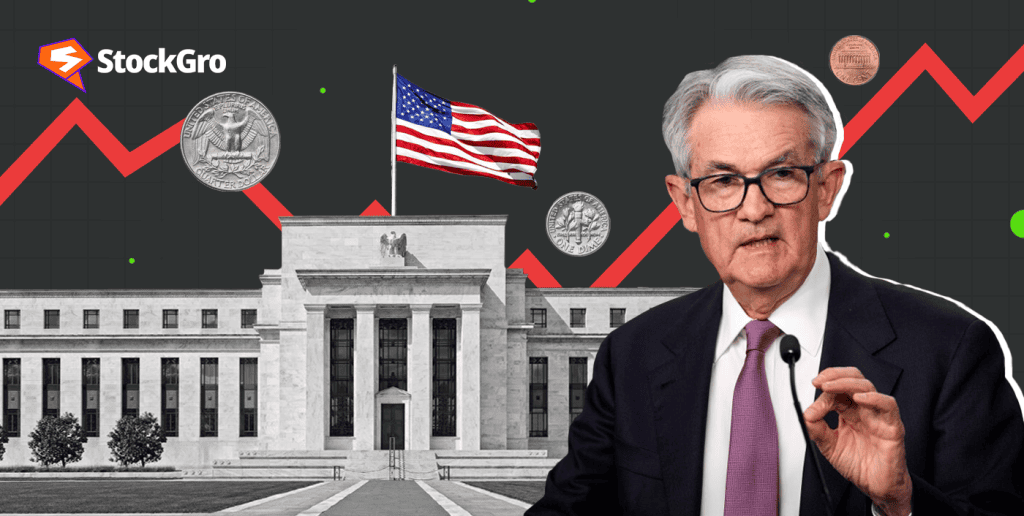
The US Federal Reserve lowered interest rates by 0.25 percentage points to 4.25-4.50% on December 18, 2024. They also signalled that future rate cuts might happen at a slower pace. Stock markets worldwide, including India’s, plunged sharply in response.
This was the Fed’s third straight rate cut in 2024 and second consecutive 0.25 percentage point reduction. Rates have declined by a full percentage point since September, when the Fed started cutting them, pointing to price stabilisation and desiring to avert economic weakening.
Why is the Fed cutting interest rates?
The Federal Reserve has cut down on the interest rate after months of disturbing labour market trends in the US. In August 2024, unemployment stood at 4.2%, meaning 7.1 million people were unemployed—a rather big decline from last year’s figures when the unemployment level was 3.8% and 6.3 million people had no work.
Besides that, inflationary pressures have been a global concern. The rate cut marked the latest manoeuvre in the efforts of the Fed to bring the economy down for a “soft landing” from the high inflation that had spiked in late 2021 and early 2022.
But the Fed’s rate cut moves have global ripples. They influence financial conditions and economies far beyond US borders.
Also read: Dixon Technologies and Vivo Partner to Manufacture Smartphones in India
Effects of Fed rate cut on financial markets
The Indian stock markets, represented by the Sensex and Nifty 50 indices, fell over 1% each on Thursday after the US Federal Reserve came out with an outlook of future interest rate cuts.
The Sensex declined by 1010 points to 79,171, while the Nifty had plunged by 302 points at 23,895.
Indian stock markets fell sharply on all major Indian stocks. Indian stocks such as State Bank of India, Infosys, Asian Paints, Tata Steel declined; global financial markets witnessed big tumbles with all the major indices on Wall Street ending as much as 3% lower.
The Fed cut rates by 25 basis points as expected but indicated only two additional cuts of 25 basis points in 2025, less than the three or four cuts widely expected by the market. The unanticipated hawkishness from the Fed outlook caught the market by surprise.
Must read: ITC announces hotel business demerger effective January 1, 2025
Broader economic impacts
A Federal Reserve rate cut has an impact on several aspects of the economy, directly on inflation, employment, economic growth, and borrowing costs:
- Rate cuts can lead to increased spending and investment, hence increasing demand for goods and services. If this demand exceeds supply, then inflation will increase.
- In low inflation or deflationary periods, rate cuts help restore balance by spurring economic activity, which then stabilises prices.
- Lower rates facilitate borrowing at cheaper costs for companies, allowing them to invest in new projects, expand the scope of their operations, and hire more employees.
- Rate cuts reduce financial burdens that may otherwise force companies into layoffs during economic downturns.
- A cut in rates increases economic activity due to lower borrowing costs, thereby increasing disposable income available to consumers. Businesses are also saved from higher financing costs.
- Cutting the rate usually reduces bond yields. Newly issued bonds with low interest rates are not very appealing, and existing bonds, being more attractive with high yields, raise their prices.
- Less expensive loans for home, car, and credit cards result in more spending by the consumer.
Put simply, the ripple effects of a cut by the Federal Reserve propagate across the economy and financial systems affecting expenditure, saving, and investment decisions and even worldwide economic conditions.
You may also like: Adani Group unites Sanghi and Penna Cement under Ambuja Cements
Future rate cut analysis
Inflation, a measure of how fast prices are growing, has reached 2.7% this November in the United States.
Though inflation has “eased significantly,” it still remains slightly above the 2% long-term goal of the Federal Reserve, Fed Chair Jerome Powell commented during a press briefing Wednesday.
The Fed intends to reduce the speed of its easing measures, indicating only two possible rate cuts in 2025. Powell was positive about the current state of the US economy and stated that the Fed is now “significantly closer” to completing the current cycle of easing.
Still, analysts warn that policies floated by President-elect Donald Trump, including tax cuts and sweeping import tariffs, may continue to put upward pressure on prices and send inflation even higher.
Strategic responses to Fed rate changes
The need to understand and adapt to Federal Reserve rate changes is critical for many stakeholders.
Rate changes can change the market dynamics, affecting stocks, bonds, and real estate. Diversification of investments can help manage risks. When the rates are cut, bond prices tend to rise. Investors may opt for longer-duration bonds to gain better returns.
Rate cuts often favor growth-oriented stocks as borrowing becomes cheaper for companies.
Also, lower rates allow refinancing of mortgages, student loans, or car loans to reduce monthly payments.
Lower rates do not increase returns on savings; instead, consumers can look for higher-yielding instruments or invest in long-term assets.
Bottomline
Federal Reserve rate changes impact the economy, financial markets, and individual financial decision-making. Whether it is aimed at controlling inflation, stabilising employment or mitigating global economic risks, the change has significant implications in all these areas.
For stakeholders, strategic planning and adaptability are a way of surviving the shifts. By knowing how rate changes create ripples and preparing for that, investors, businesses, and consumers can minimise risks and maximise opportunities.
In the light of increasingly interlinked global economies, staying abreast and being proactive in the face of Fed rate changes has never been more crucial.

